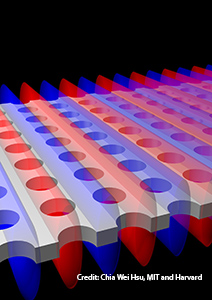
Light is confined within a planar slab with periodic array of holes, although the light is "allowed" to escape. Blue and red indicate the electric field density.
Researchers in Cambridge, Massachusetts, U.S.A., have found a new way to trap a beam of light without restricting the passage of the light, like other existing methods do. Methods like metallic mirrors, photonic bandgap materials, or highly disordered media mirrors confine light at every incident wavelength by forbidding outgoing waves. Now, an interdisciplinary group from Harvard and MIT report using a photonic crystal to trap light of a particular wavelength without trapping other nearby wavelengths, an important goal in science and technology.
The new phenomenon works by destructive interference in a 180-nm‒thick dielectric slab patterned with an array of cylindrical channels 160 nm wide and 336 nm apart, a type of photonic crystal (Nature 499, 159). Graduate student Chia Wei Hsu and colleagues first predicted the phenomenon via computer modeling; then they devised a system to demonstrate it. The set up uses a supercontinuum laser beam to produce light at an angle normal to the photonic crystal surface, which is submerged in a colorless liquid. At the interface of the slab and medium, each wave is partly transmitted into the medium as an outgoing plane wave, and partly reflected back into the slab. As the transmitted light emerges through different channels, waves of opposite amplitude interfere and cancel each other. The phenomenon is applicable not only to light of all wavelengths, but to sound waves, electrons and even water waves.
As a realization of the “bound state in the continuum” predicted by mathematician and computational pioneer John von Neumann in 1929, the new phenomenon is expected to enable new applications, such as large-area lasers or novel types of chemical and biological sensors.
